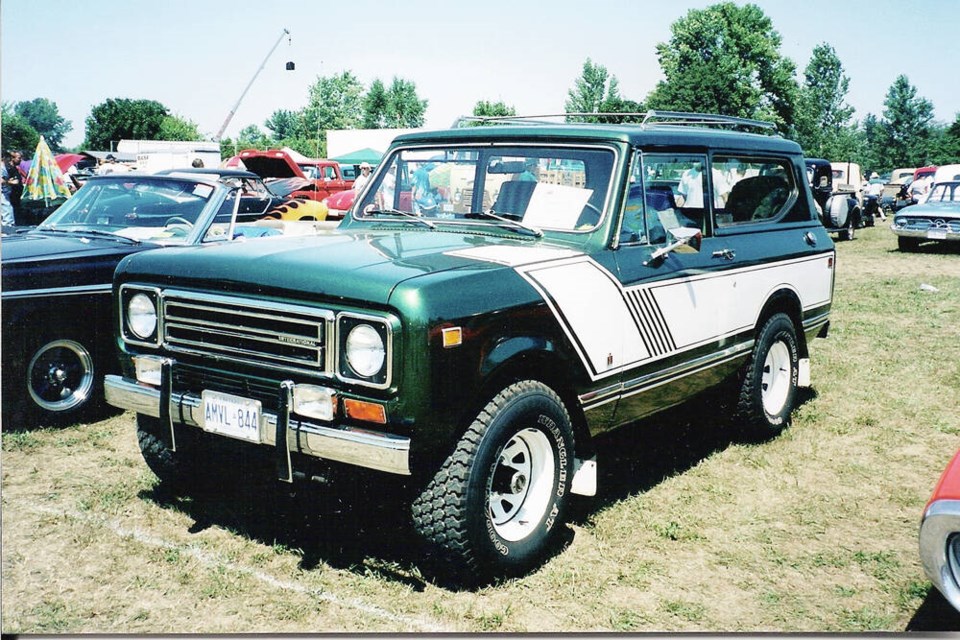The International Harvester Co.’s roots can be traced back to the invention of the grain reaper by Cyrus Hall McCormick of Virginia in 1831. As consolidation began taking place in the industry, McCormick Harvester joined with some other implement companies in 1902 to form the International Harvester Co.
Although known principally for heavy trucks and farm machinery, IHC made some passenger vehicles. From 1907 to 1911 it built both high-wheeler “Auto Buggie” types and conventional touring cars. It even manufactured occasional cars on truck chassis into the 1930s, and produced truck-based “woody” station wagons from the 1930s to the ’50s. This was followed by a large, all-steel Travelall station wagon similar to the Chevrolet/GMC Suburban.
In the late 1950s IHC observed the rising demand for versatile utility vehicles from the industrial and agricultural sectors into the recreational off-road market.
The sport utility vehicle had been created and popularized by Willys-Overland when it marketed a civilian version of its military Jeep following the Second World War. IHC identified the trend quite early when the main players were just the American Jeep, British Land Rover and Japanese Toyota Land Cruiser.
In 1961 International Harvester introduced its Scout sport utility vehicle, a rugged two/four-wheel driver that would quickly become the fastest selling product in IHC’s history. It was bigger, more refined and more powerful than the small traditional Jeep CJ-5. Its 2,540 mm (100 in.) wheelbase was 483 mm (19 in.) longer that the CJ-5’s 2,057 mm (81 in.), or about the same size as the larger Jeep CJ6’s 2,565 mm, (101 in.).
The Scout’s 2.5 litre, “Comanche” slant-four, overhead valve engine was created by cutting the right bank off their 5.0 litre truck V-8. It developed 93 horsepower, substantially more than the CJ’s 2.2 litre 75 horsepower F-head four. Two-wheel drive was standard with four-wheel drive and limited slip differential optional.
The Scout’s styling resembled a small pick-up truck with integrated cab and cargo box. There was a single bench seat and the roof and doors could be removed and windshield folded forward for a sporty feel. To keep cargo dry an optional top could be ordered for the pickup bed.
The Scout’s performance was reasonable. Car Life (6/61) recorded zero to 60 mph (97 km/h) in 20.1 seconds, and estimated top speed at 80 mph (129 km/h). But there were some criticisms. The testers noted that the removable steel top leaked “like a sieve.” Also, the rugged clutch and three-speed transmission’s stiff floor-mounted shifter made it a “real man’s car.”
Wind-up windows came in 1963, and in 1965 the 2.5 engine was made available with turbocharging increasing horsepower from 93 to 111. A four-speed transmission became optional. Then for 1966 a larger 3.2 litre four (half a 6.4 litre V-8), and 4.4 litre overhead valve V-8 were offered.
Creature comforts were also upgraded along the way with a smarter interior and improved sound insulation to counter competition from the new 1966 Ford Bronco and coming 1969 Chevrolet Blazer and 1970 GMC Jimmy.
Another power boost came in 1969 by increasing the V-8’s displacement to 5.0 litres. It also received such enhancements as two-tone metallic paint, chrome plated wheels, wider tires and carpeted and padded interior.
Recognizing that the time had come for a new model, IHC introduced the all-new wider and lower 1971 Scout II; the old Scout overlapped it for a year. Although the same 2,540 mm (100 in.) wheelbase was used, some increased passenger space was somehow found.
The Scout II offered a wide choice of power teams. In addition to the standard 3.2 litre four, there was an optional turbo four, a 3.8 litre American Motors inline six, and 5.0 and 5.7 litre V-8s. Three- or four-speed manuals and an automatic transmission were available along with such conveniences as power steering, power brakes and air conditioning.
By 1975 IHC had discontinued the big Travelall and pickup but kept the Scout II which moved through the 1970s without major changes, although it got several stripe and decal variations.
As a Travelall replacement, a stretched 2,997 mm (118 in.) wheelbase Scout II called the Traveler was introduced in 1976. A Scout pickup, the Terra, also came on this wheelbase, and an optional 3.2 litre Nissan diesel engine was available.
The Scout II was discontinued in 1980 after more than 530,000 Scouts had been built. Although a new one was designed it was not brought to market. In view of the explosion in SUV sales that would ensue, IHC may have wished it had stayed in the business.
IHC was experiencing financial difficulties and in 1985 would sell its agricultural equipment division to Tenneco’s J.I. Case Co. Heavy International trucks continued to be manufactured by a reorganized company called Navistar International Corp.



